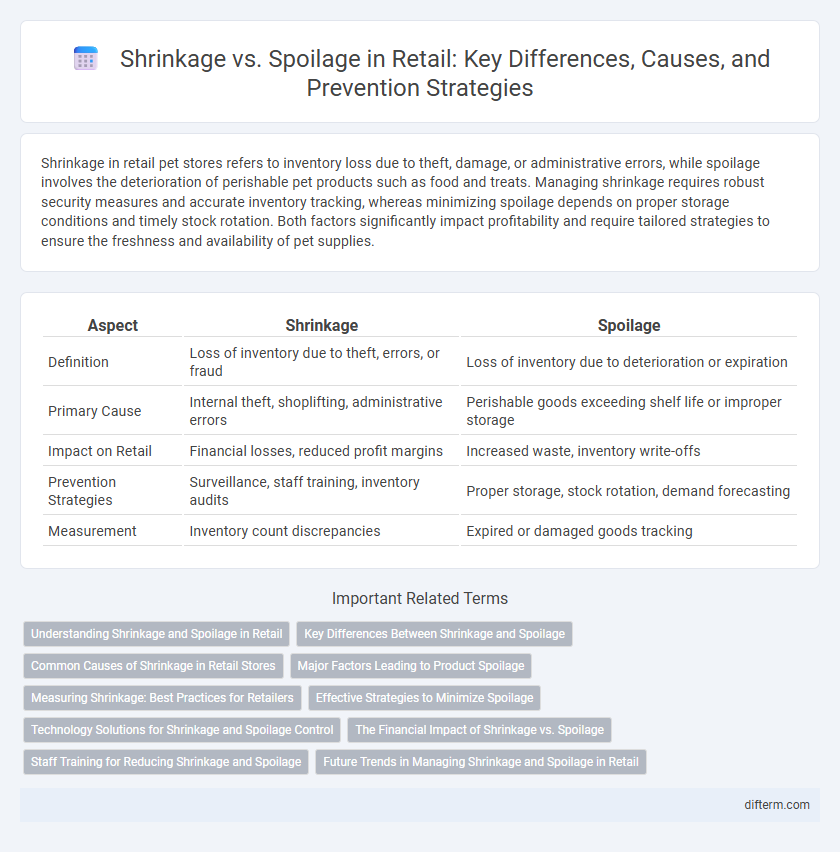Shrinkage in retail pet stores refers to inventory loss due to theft, damage, or administrative errors, while spoilage involves the deterioration of perishable pet products such as food and treats. Managing shrinkage requires robust security measures and accurate inventory tracking, whereas minimizing spoilage depends on proper storage conditions and timely stock rotation. Both factors significantly impact profitability and require tailored strategies to ensure the freshness and availability of pet supplies.
Table of Comparison
| Aspect | Shrinkage | Spoilage |
|---|---|---|
| Definition | Loss of inventory due to theft, errors, or fraud | Loss of inventory due to deterioration or expiration |
| Primary Cause | Internal theft, shoplifting, administrative errors | Perishable goods exceeding shelf life or improper storage |
| Impact on Retail | Financial losses, reduced profit margins | Increased waste, inventory write-offs |
| Prevention Strategies | Surveillance, staff training, inventory audits | Proper storage, stock rotation, demand forecasting |
| Measurement | Inventory count discrepancies | Expired or damaged goods tracking |
Understanding Shrinkage and Spoilage in Retail
Shrinkage in retail refers to the loss of inventory due to theft, administrative errors, or supplier fraud, directly impacting profitability. Spoilage specifically involves the deterioration of perishable goods such as food or pharmaceuticals, leading to unsellable stock and increased waste management costs. Effective shrinkage and spoilage management requires accurate inventory tracking, staff training, and optimized stock rotation to minimize financial losses.
Key Differences Between Shrinkage and Spoilage
Shrinkage in retail refers to the loss of inventory due to theft, administrative errors, or vendor fraud, while spoilage specifically pertains to the deterioration of perishable goods rendering them unsellable. Key differences include that shrinkage primarily affects both non-perishable and perishable items through external or internal theft, whereas spoilage exclusively impacts perishable products due to expiration, poor storage conditions, or damage. Effective inventory management systems and regular audits help mitigate shrinkage, while proper stock rotation and temperature controls are essential to reducing spoilage.
Common Causes of Shrinkage in Retail Stores
Shrinkage in retail stores primarily results from theft, including shoplifting and employee theft, which accounts for a significant portion of inventory loss. Administrative errors, such as inaccurate pricing, mislabeling, or faulty record-keeping, also contribute to shrinkage by creating discrepancies between actual and recorded inventory. Additionally, damaged goods, improper stock handling, and supplier fraud further elevate shrinkage rates, impacting overall store profitability.
Major Factors Leading to Product Spoilage
Major factors leading to product spoilage in retail include improper storage conditions such as incorrect temperature and humidity levels, which accelerate microbial growth and chemical degradation. Exposure to light and air also contributes to the oxidation and spoilage of perishable goods. Furthermore, inefficient inventory management results in prolonged shelf life, increasing the risk of spoilage before sale.
Measuring Shrinkage: Best Practices for Retailers
Measuring shrinkage in retail involves accurately tracking inventory discrepancies caused by theft, administrative errors, and vendor fraud. Implementing regular stock audits and leveraging advanced inventory management systems enhances the precision of shrinkage calculations. Retailers benefit from real-time data analysis to identify shrinkage patterns and develop targeted loss prevention strategies.
Effective Strategies to Minimize Spoilage
Implementing inventory management systems with real-time tracking can significantly reduce spoilage by ensuring proper stock rotation and timely discounts on perishable goods. Utilizing temperature-controlled storage and frequent quality inspections helps maintain product freshness and prevent premature degradation. Training staff on handling procedures and improving supplier communication further minimizes spoilage risks, enhancing overall retail profitability.
Technology Solutions for Shrinkage and Spoilage Control
Advanced RFID tracking and IoT sensor technologies enhance shrinkage and spoilage control by providing real-time inventory monitoring and temperature management in retail environments. Automated data analytics platforms identify patterns in product loss, enabling proactive interventions to minimize theft, damage, and expired goods. Integrating AI-powered surveillance systems with supply chain management tools boosts accuracy in detecting shrinkage and spoilage, optimizing inventory turnover and profitability.
The Financial Impact of Shrinkage vs. Spoilage
Shrinkage in retail, often caused by theft, administrative errors, and supplier fraud, leads to significant financial losses estimated at nearly $100 billion annually in the U.S. Spoilage, primarily affecting perishable goods, results in reduced inventory value and increased waste management costs, impacting profit margins especially in grocery and fresh produce sectors. Effective loss prevention strategies targeting shrinkage and improved inventory turnover to minimize spoilage are critical for maximizing retail profitability.
Staff Training for Reducing Shrinkage and Spoilage
Effective staff training in retail emphasizes proper inventory handling, accurate stock rotation, and vigilant monitoring techniques to significantly reduce shrinkage and spoilage. Educating employees on identifying damaged goods and implementing standardized processes minimizes product loss and improves overall store profitability. Regular refresher courses and performance evaluations reinforce best practices, ensuring consistent inventory control and waste reduction.
Future Trends in Managing Shrinkage and Spoilage in Retail
Emerging technologies like AI-powered inventory management and IoT-enabled supply chain monitoring are revolutionizing how retailers detect and prevent shrinkage and spoilage. Predictive analytics enhance demand forecasting, reducing overstock and minimizing waste, while blockchain solutions improve transparency and traceability across the retail supply chain. Sustainable practices and automation integration are set to further drive efficiency and loss prevention in future retail operations.
Shrinkage vs Spoilage Infographic

 difterm.com
difterm.com